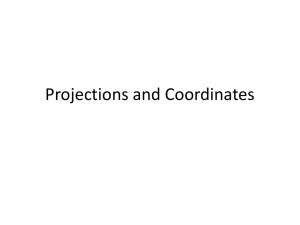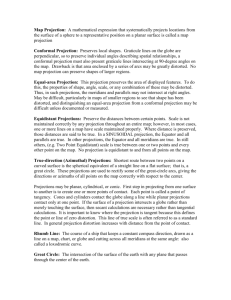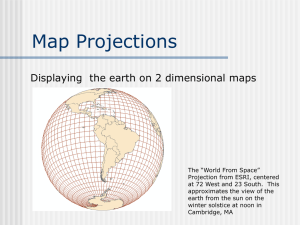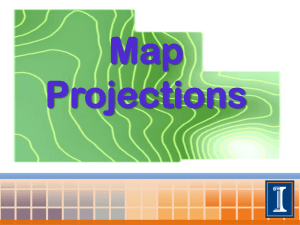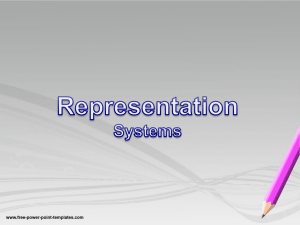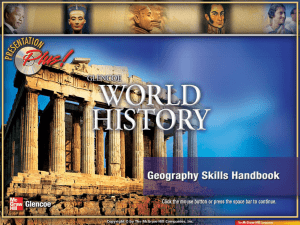Topographic Maps
advertisement
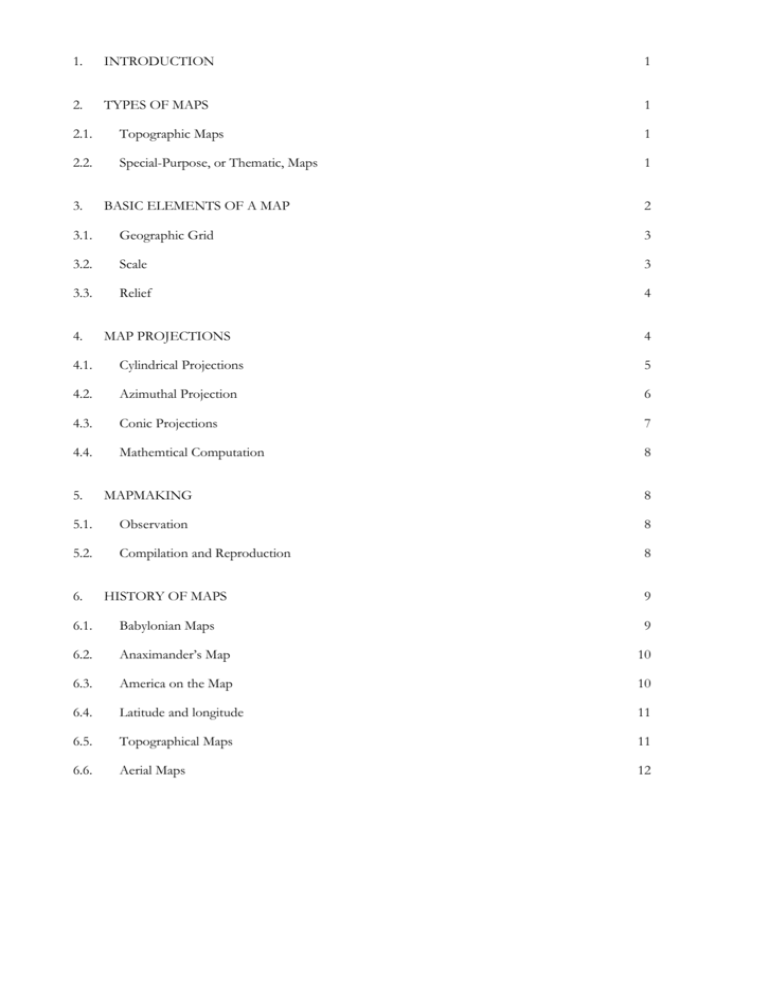
1. INTRODUCTION 1 2. TYPES OF MAPS 1 2.1. Topographic Maps 1 2.2. Special-Purpose, or Thematic, Maps 1 3. BASIC ELEMENTS OF A MAP 2 3.1. Geographic Grid 3 3.2. Scale 3 3.3. Relief 4 4. MAP PROJECTIONS 4 4.1. Cylindrical Projections 5 4.2. Azimuthal Projection 6 4.3. Conic Projections 7 4.4. Mathemtical Computation 8 5. MAPMAKING 8 5.1. Observation 8 5.2. Compilation and Reproduction 8 6. HISTORY OF MAPS 9 6.1. Babylonian Maps 9 6.2. Anaximander’s Map 10 6.3. America on the Map 10 6.4. Latitude and longitude 11 6.5. Topographical Maps 11 6.6. Aerial Maps 12 A Short History Of Maps 1 1. Introduction Map, representation of a geographic area, usually a portion of the earth's surface, drawn or printed on a flat surface. In most instances a map is a diagrammatic rather than a pictorial representation of the terrain; it usually contains a number of generally accepted symbols, which indicate the various natural, artificial, or cultural, features of the area it covers. 2. Types of Maps Maps may be used for a variety of purposes, and as a result a number of specialized types of maps have been developed. 2.1. Topographic Maps The basic type of map used to represent land areas is the topographic map. Such maps show the natural features of the area covered as well as certain artificial features, known as cultural features. Political boundaries, such as the limits of towns, countries, and states, are also shown. Because of the great variety of information included on them, topographic maps are most often used as general reference maps. 2.2. Special-Purpose, or Thematic, Maps Among the most important of the special-purpose maps are hydrographic and aviation charts. Hydrographic charts are used for the navigation of ships and cover the surface of the oceans and other large bodies of water and their shores. Over the water portion of a chart, depths are shown at frequent intervals by printing the number of fathoms of water at low tide. Shoal areas are circled or shaded to give them greater visibility, and the limits of channels are shown by lines. The type of bottom, such as sand, mud, or rock, is also indicated. An important feature of such charts is the exact location of lighthouses, buoys, and other aids to navigation. The only other shore features shown on a chart are such landmarks as tall buildings or prominent peaks on which a navigator may wish to take a bearing. Aviation charts Monna Kaijomaa 18.2.2016 A Short History Of Maps 2 for use over land somewhat resemble topographic maps but bear in addition the location of radio beacons, airways, and the areas covered by the beams of radio range stations. Other special-purpose maps include political maps, which show only towns and political divisions without topographic features; geologic maps, showing the geologic structure of an area; and maps indicating the geographic distribution of crops, land use, rainfall, population, and hundreds of other kinds of social and scientific data. Another useful type of map is the relief map, which is a three-dimensional model of the terrain of an area. Such maps are usually carved out of clay or plaster of paris. To emphasize relief, the vertical scale of relief maps is usually several times the horizontal scale. Such maps can also be manufactured by stamping plastic sheets in a mold. Relief maps are extensively used in military and engineering planning. 3. Basic Elements of a Map For a map to contain a large amount of easily read information, a system of symbols must be employed. Many commonly used symbols have become generally accepted or are readily understood. Thus cities and towns are indicated by dots or patches of shading; streams and bodies of water are often printed in blue; and political boundaries are shown by colored ribbons or dotted lines. A cartographer, as mapmakers are called, may, however, devise a great variety of symbols to suit various needs. For example, a dot may be used to symbolize the presence of 10,000 head of cattle, or crossed pickaxes may be used to denote the location of a mine. The symbols used on a map are defined in the map's key, or legend. Monna Kaijomaa 18.2.2016 A Short History Of Maps 3.1. Geographic Grid 3 In order to locate a feature on a map or to describe the extent of an area, it is necessary to refer to the map's geographic grid. This grid is made up of meridians of longitude and parallels of latitude. By agreed convention, longitude is marked 180° east and 180° west from 0° at Greenwich, England. Latitude is marked 90° north and 90° south from the 0° parallel of the equator. Points on a map can be accurately defined by giving degrees, minutes, and seconds for both latitude and longitude (see Latitude and Longitude). Maps are usually arranged so that true north is at the top of the sheet, and are provided with a compass rose or some other indication of magnetic variation (see Magnetic Pole). 3.2. Scale The scale to which a map is drawn represents the ratio of the distance between two points on the earth and the distance between the two corresponding points on the map. The scale is commonly represented in figures, as 1:100,000, which means that one unit measured on the map (say 1 cm) represents 100,000 of the same units on the earth's surface. A map to this scale is also sometimes called a centimeter-to-the-kilometer map. On most maps the scale is indicated in the margin, and frequently a divided line showing the scale length of such units as 1, 5, and 10 km or mi, or both, on the original area is provided. The scales used in maps vary widely. Ordinary topographic maps, such as those of the U.S. issued by the U.S. Geological Survey, are usually made to a scale of 1:62,500 (about 1 in to the mile). For military purposes scales as large as 1:15,800 are used. Since the early years of the 20th century, a number of governments have been collaborating on a standard map of the world at a scale of 1:1,000,000. Monna Kaijomaa 18.2.2016 A Short History Of Maps 3.3. Relief 4 The varying heights of hills and mountains, and the depths of valleys and gorges as they appear on a topographic map, are known as relief; unless the relief is adequately represented, the map does not give a clear picture of the area it represents. In the earliest maps, relief was often indicated pictorially by small drawings of mountains and valleys, but this method is extremely inaccurate and has been generally supplanted by a system of contour lines. The contour lines represent points in the mapped area that are at equal elevations. The contour interval selected may be any unit, depending on the amount of relief and the scale of the map, such as 50 m, and in drawing the map the cartographer joins together all points that are at a height of 50 m above sea level, all points at a height of 100 m, all points at a height of 150 m, and so on. The shapes of the contour lines provide an accurate representation of the shapes of hills and depressions, and the lines themselves show the actual elevations. Closely spaced contour lines indicate steep slopes. Other methods of indicating elevation include the use of colors or tints, and of hachures (short parallel lines) or shadings. When colors are used for this purpose, a graded series of tones is selected to color areas of similar elevations; for example, all the land between 0 and 100 m above sea level may be colored a light shade of green, all land between 100 and 200 m a darker shade, and so on. Hachures are used to show slopes; they are made heavier and closer together for steeper slopes. Often only southeast slopes are hachured or shaded, giving somewhat the effect of a bird's-eye view of the area illuminated by light from the northwest. Shadings or carefully drawn hachures, neither of which give elevations, are more easily interpreted than contour lines and are sometimes used in conjunction with them for greater clarity. 4. Map Projections For the representation of the entire surface of the earth without any kind of distortion, a map must have a spherical surface; a map of this kind is known as a globe. A flat map cannot accurately represent the rounded surface of the earth except for very small areas where the curvature is negligible. To show large portions of the Monna Kaijomaa 18.2.2016 A Short History Of Maps 5 earth's surface or to show areas of medium size with accuracy, the map must be drawn in such a way as to compromise among distortions of areas, distances, and direction. In some cases the cartographer may wish to achieve accuracy in one of these qualities at the expense of distortion in the others. The various methods of preparing a flat map of the earth's surface are known as projections and are classified as geometric or analytic, depending on the technique of development. Geometric projections are classified according to the type of surface on which the map is assumed to be developed, such as cylinders, cones, or planes; plane projections are also known as azimuthal or zenithal projections. Analytical projections are developed by mathematical computation. 4.1. Cylindrical Projections In making a cylindrical projection, the cartographer regards the surface of the map as a cylinder that encircles the globe, touching it at the equator. The parallels of latitude are extended outward from the globe, parallel to the equator, as parallel planes intersecting the cylinder. Because of the curvature of the globe, the parallels of latitude nearest the poles when projected onto the cylinder are spaced progressively closer together, and the projected meridians of longitude are represented as parallel straight lines, perpendicular to the equator and continuing to the North and South poles. After the projection is completed, the cylinder is assumed to be slit vertically and rolled out flat. The resulting map represents the world's surface as a rectangle with equally spaced parallel lines of longitude and unequally spaced parallel lines of latitude. Although the shapes of areas on the cylindrical projection are increasingly distorted toward the poles, the size relationship of areas on the map is equivalent to the size relationship of areas on the globe. Monna Kaijomaa 18.2.2016 A Short History Of Maps 6 The familiar Mercator projection, developed mathematically by the Flemish geographer Gerardus Mercator, is related to the cylindrical projection, with certain modifications. A Mercator map is accurate in the equatorial regions but greatly distorts areas in the high latitudes. Directions, however, are represented faithfully, and this is especially valuable in navigation. Any line cutting two or more meridians at the same angle is represented on a Mercator map as a straight line. Such a line, called a rhumb line, represents the path of a ship or an airplane following a steady compass course. Using a Mercator map, a navigator can plot a course simply by drawing a line between two points and reading the compass direction from the map. See Navigation. 4.2. Azimuthal Projection This group of map projections is derived by projecting the globe onto a plane that may be tangent to it at any point. The group includes the gnomonic, orthographic, and stereographic plane projections. Two other types of plane projections are known as the azimuthal equal area and the azimuthal equidistant; they cannot be projected but are developed on a tangent plane. The gnomonic projection is assumed to be formed by rays projected from the center of the earth. In the orthographic projection the source of projecting rays is at infinity, and the resulting map resembles the earth as it would appear if photographed from outer space. The source of projecting rays for the stereographic projection is a point diametrically opposite the tangent point of the plane on which the projection is made. The nature of the projection varies with the source of the projecting rays. Thus the gnomonic projection covers areas of less than a hemisphere, the orthographic covers hemispheres, the azimuthal equal area and the stereographic projections map larger areas, and the azimuthal equidistant includes the entire globe. In all these types of projection, however (except in the case of the azimuthal equidistant), the portion of the earth that appears on the map depends on the point at which the imaginary plane touches the earth. A plane-projection map with the plane tangent to the surface of the earth at the equator would represent the equatorial region, but would not show the entire region in one map; with the plane tangent at either of the poles, the map would represent the polar regions. Monna Kaijomaa 18.2.2016 A Short History Of Maps 7 Because the source of the gnomonic projection is at the center of the earth, all great circles, that is, the equator, all meridians, and any other circles that divide the globe into two equal parts, are represented as straight lines. A great circle that connects any two points on the earth is always the shortest distance between the two points. The gnomonic map is therefore a great aid to navigation when used in conjunction with the Mercator. 4.3. Conic Projections In preparing a conic projection a cone is assumed to be placed over the top of the globe. After projection, the cone is assumed to be slit and rolled out to a flat surface. The cone touches the globe at all points on a single parallel of latitude, and the resulting map is extremely accurate for all areas near that parallel, but becomes increasingly distorted for all other areas in direct proportion to the distance of the areas from the standard parallel. To provide greater accuracy, the Lambert conformal conic projection assumes a cone that passes through a part of the surface of the globe, intersecting two parallels. Because the resulting map is accurate in the immediate vicinity of both parallels, the area represented between the two standard parallels is less distorted than the same area reproduced by a single conic projection. The polyconic projection is a considerably more complicated projection in which a series of cones is assumed, each cone touching the globe at a different parallel, and only the area in the immediate vicinity of each parallel is used. By compiling the results of the series of limited conic projections, a large area may be mapped with considerable accuracy. Because a cone cannot be made to touch the globe in the extreme polar and equatorial regions, the various conic projections are used to map comparatively small areas in the temperate zones. Polyconic maps offer a good compromise in the representation of area, distance, and direction over small areas. Monna Kaijomaa 18.2.2016 A Short History Of Maps 4.4. Mathemtical Computation 8 For accurate delineation of large areas on a small scale, a number of so-called projections have been developed mathematically. Maps based on mathematical computation represent the entire earth in circles, ovals, or other shapes. For special purposes the earth often is drawn not within the original form of the projection but within irregular, joined parts. Maps of this type, called interrupted projections, include Goode's interrupted homolosine and Eckert's equal-area projection. 5. Mapmaking Mapmaking, or cartography, has been greatly assisted by technological advancements since World War II. Perhaps most important has been the use of remote sensing techniques, that is, techniques that gather data about an object without actually touching it. Examples include aerial photography (including infrared photography) and satellite photography. Satellite triangulation has substantially reduced the margin of error in determining the exact location of points on the earth's surface. Among the more recent innovations has been the use of the computer to draw maps. 5.1. Observation The basis of a modern map is a careful survey giving geographical locations and relations of a large number of points in the area being mapped. Today, nearly all original maps make use of aerial photographs in addition to traditional land-surveying information (see Aerial Survey; Surveying). Satellite photographs can furnish a wealth of accurate information about various features on the earth's surface, including the location of mineral deposits, the extent of urban sprawl, vegetation infestations, and soil types. 5.2. Compilation and Reproduction Once the data have been collected, the map must be carefully planned with regard to its final use so that all relevant information can be rendered clearly and accurately. Monna Kaijomaa 18.2.2016 A Short History Of Maps 9 The collected surveys and photographs are then used to enter a large number of points on a grid of crossed lines corresponding to the projection chosen for the map. Elevations are determined and contour lines, if used, are drawn directly from stereoscopic pairs of photographs by using very complex instruments such as the multiplex. The courses of roads and rivers and the positions of other features are drawn in the same way. Final preparation of a map for printing begins by making a series of sheets, one for each color used on the map. These sheets are made of an opaque coated plastic; lines and symbols are scribed onto the surface by a sharp etching tool that removes the opaque coating. Each such sheet is a negative from which a lithographic plate is made. See Lithography. Another type of map is an orthophotomap, in which actual photographs form the body of the map. Such a map is a mosaic of carefully pieced portions of aerial photographs, which have been changed by the use of an orthophotoscope to eliminate scale and angle distortion. During the 1970s advancements were made in computergenerated maps. Data can be stored on the coordinates of a geographic area and on the distribution of statistical phenomena in the area. A device such as a continuouscurve plotter enables a computer to draw accurate maps from the stored data. Computer-generated maps can also be displayed on a video screen, where an operator can easily make alterations in the content. Because such maps, and each incorporated change, can be stored in the computer, they are useful in furnishing an animated picture of a change over a period of time. 6. History of Maps 6.1. Babylonian Maps The earliest existing maps were made by the Babylonians about 2300 bc. Cut on clay tiles, they consisted largely of land surveys made for the purposes of taxation. More extensive regional maps, drawn on silk and dating from the 2nd century bc, have been found in China. The ability and need to make maps would appear to be universal. One of the most interesting types of primitive map is the cane chart constructed by the Marshall Islanders in the South Pacific Ocean. This chart is made of Monna Kaijomaa 18.2.2016 A Short History Of Maps 10 a gridwork of cane fibers arranged to show the location of islands. The art of mapmaking was advanced in both the Maya and Inca civilizations, and the Inca as early as the 12th century ad made maps of the lands they conquered. 6.2. Anaximander’s Map The first map to represent the known world is believed to have been made in the 6th century bc by the Greek philosopher Anaximander. It was circular in form and showed the known lands of the world grouped around the Aegean Sea at the center and surrounded by the ocean. One of the most famous maps of classical times was drawn by the Greek geographer Eratosthenes about 200 bc. It represented the known world from England on the northwest to the mouth of the Ganges River on the east and to Libya on the south. This map was the first to be supplied with transverse parallel lines to show equal latitudes. The map also had some meridians of longitude but they were irregularly spaced. About ad 150 the Alexandrian scholar Ptolemy published his geography containing maps of the world. These were the earliest maps to use a mathematically accurate form of conic projection, although they incorporated many errors, such as the excessive extent of the Eurasian landmass. Following the fall of the Roman Empire, European mapmaking all but ceased; such maps as were made were usually drawn by monks, who often portrayed the earth inaccurately. Arabian seamen, however, made and used highly accurate charts during this same period. The Arabian geographer al-Idrisi made a map of the world in 1154. Beginning approximately in the 13th century, Mediterranean navigators prepared accurate charts of that sea, usually without meridians or parallels but provided with lines to show the bearings between important ports. These maps are usually called portolano or portolan charts. In the 15th century, editions of Ptolemy's maps were printed in Europe; for the next several hundred years these maps exerted great influence on European cartographers. 6.3. America on the Map A map produced in 1507 by Martin Waldseemüller, a German cartographer, probably was the first to apply the name America to the newly discovered transatlantic lands. The map, printed in 12 separate sheets, was also the first to clearly separate Monna Kaijomaa 18.2.2016 A Short History Of Maps 11 North and South America from Asia. In 1570 Abraham Ortelius, a Flemish mapmaker, published the first modern atlas, Orbis Terrarum. It contained 70 maps. During the 16th century many other cartographers produced maps that incorporated the ever-increasing information brought back by navigators and explorers. It is Gerardus Mercator, however, who stands as the greatest cartographer of the age of discovery; the projection he devised for his world map proved invaluable to all future navigators. 6.4. Latitude and longitude The accuracy of later maps was greatly increased by more precise determinations of latitude and longitude and of the size and shape of the earth. The first maps to show compass variation were produced in the first half of the 17th century, and the first charts to show ocean currents were made about 1665. By the 18th century, the scientific principles of mapmaking were well established and the most notable inaccuracies in maps involved unexplored parts of the world. 6.5. Topographical Maps By the late 18th century, as the initial force of world exploration subsided and as nationalism began to develop as a potent force, a number of European countries began to undertake detailed national topographic surveys. The complete topographic survey of France was issued in 1793; roughly square, it measured about 11 m (about 36 ft) on each side. Britain, Spain, Austria, Switzerland, and other countries followed suit. In the United States the Geological Survey was organized in 1879 for the purpose of making large-scale topographic maps of the entire country. In 1891 the International Geographical Congress proposed the mapping of the entire world on a scale of 1:1,000,000, a task that still remains to be completed. During the 20th century, mapmaking underwent a series of major technical innovations. Monna Kaijomaa 18.2.2016 A Short History Of Maps 12 6.6. Aerial Maps Aerial photography was developed during World War I and used extensively during World War II in the making of maps. Beginning in 1966 with the launching of the satellite Pageos, and continuing in the 1970s with the three Landsat satellites, the U.S. has been engaged in a complete geodetic survey of the surface of the earth by means of high-resolution photographic equipment. In spite of the great advancements in cartographic technique and knowledge, substantial portions of the earth's surface have not been surveyed in detail. Surveying work continues, for instance, on the continent of Antarctica. Monna Kaijomaa 18.2.2016

